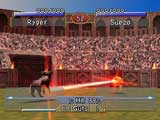 |
|
|
 Every once in awhile,
big trends hit the gaming world. In the early 90s 3D shooters were all the rage.
Point-and-click story games have had their heyday, and FMV story-movies have all but come
and gone. Currently, as anybody with ears on their head will tell you, the big thing is
virtual monsters. Stemming from the virtual pet craze begun in Japan, games like Pokemon
and Jade Coccoon have dominated the market. Early in the digipe (the Japanese word
for digital pets) revolution, Monster Rancher burst onto the scene. Now, Tecmo has
released Monster Rancher 2, a more robust version of the game, and coupled with the
popularity of the animated TV series it has developed a strong following. Every once in awhile,
big trends hit the gaming world. In the early 90s 3D shooters were all the rage.
Point-and-click story games have had their heyday, and FMV story-movies have all but come
and gone. Currently, as anybody with ears on their head will tell you, the big thing is
virtual monsters. Stemming from the virtual pet craze begun in Japan, games like Pokemon
and Jade Coccoon have dominated the market. Early in the digipe (the Japanese word
for digital pets) revolution, Monster Rancher burst onto the scene. Now, Tecmo has
released Monster Rancher 2, a more robust version of the game, and coupled with the
popularity of the animated TV series it has developed a strong following.
When you enter your monster into a tournament, it strives to defeat its opponents. You can either let your monster fight alone, or you can guide it in its efforts. If it has decent intelligence and is fairly loyal to you, most monsters do okay by themselves. But then you are left to just watch the fight. It is much more fun, and possibly more beneficial, to control your monster as he fights. You can move it closer to or further away from its opponent, and tell it when to attack. The fighting system is complicated by the fact that different moves have different attack distances, so you can only perform the attack that is available from your vantage point. Also, your monster has a Guts level that must be at a certain level before you can perform different moves. When it is hit or when it misses, the Guts number decreases, and it takes a few seconds for it to charge up again. Once you compete in a few tournaments, you are allowed to use the Shrine. The Shrine allows you to search your CDs for more monsters. Lists are available on different sites (check out www.cheatcc.com) that show what monsters can be culled from which CDs, and there are hundreds of them. Certain CDs, like the Beastie Boys' "Hello Nasty" contain special monsters. There are a lot of monsters to capture and raise, and anybody with a CD collection, game, music or other kind, already harbors dozens of the little critters. Undoubtedly, this is one of the most intriguing aspects of the game, and has helped to develop the Monster Rancher 2 fan base.The graphics are great. Everything is rendered in 3D, and the settings and monster designs are excellent. Probably mainly because there are so few action sequences, there is no problem with clipping or object boundaries at all, which is refreshing in a PSX title. The sound, however, is another story entirely. Monster Rancher 2 is plagued by the typical, at-par, midi score. Although there is a lot of dialogue between you and other characters you encounter, none of it is spoken except the occasional squeal from your monster. The major downside of Monster Rancher 2 is that I never felt really involved with my monsters. Sure, I chose how to train them, and most of them were quite loyal to me, but there is constantly a distance between trainer and monster. During drills you just watch your monster attempt the task, and there is now way to influence or skip the animation. The whole game is a series of making choices and then watching the outcome. The errantry gets incredibly tedious because the whole time you do not interact with the game at all except to prompt it to begin the next phase of training. Even during battle, you are merely suggesting moves to your monster, and you never feel totally in control. I would have liked a more fighting-game oriented control during tournaments. Occasionally your monster requests you to play with it, but even after dozens of attempts, I have yet to win or completely understand the point of this play. The distance is coupled by the continual starting and stopping in the game. It takes place on a week-by-week basis, so after you do anything you get the screen that shows the new week coming. Each month you pick food to feed your monster. You can only train one monster at a time, which creates even more busywork in going to freeze and thaw different critters. During battles you are stuck watching tedious screens that show the outcomes of the fights you aren't involved in, which breaks up the action even more. Because of the stick-slip nature of the gameplay, I found it hard to get into. Overall, Monster Rancher 2 is just one of those games. It is an innovative and creative title that manages to be in the same vein as Pokemon without being any kind of "knockoff" or imitation. But because of the way the gameplay is structured, it's one of those games that you may not find appealing right away… or ever. Regardless, millions of people, young and old, have been fascinated by this game, and understandably so. Because you already possess monsters all around you, captive in their CD tombs, Monster Rancher 2 can be more than a game – it can become a way of life. There's a lot of playing to do... |